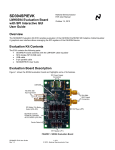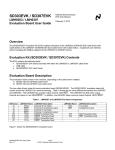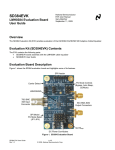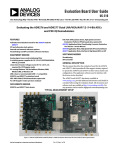Download SPA Dongle Description
Transcript
SD387EVK National Semiconductor EVK User Manual LMH0387 Evaluation Board User Guide April 29, 2010 Overview The SD387 Evaluation Kit (EVK) enables evaluation of the LMH0387 3G/HD/SD SDI Configurable I/O Adaptive Cable Equalizer / Cable Driver. A graphical user interface allows managing the SPI registers for the input mode (equalizer), and can also be used to control the device’s I/O mode. Evaluation Kit (SD387EVK) Contents The EVK contains the following parts: • SD387EVK board assembly with the LMH0387 configurable I/O • SPA dongle (SPIÆUSB card) • USB cable • 6-pin parallel cable • SD387EVK User Guide Evaluation Board Description Figure 1 shows the SD387 evaluation board and highlights some of its features. SD387EVK User Guide Rev 1.1 1 of 23 © 2010 National Semiconductor Corp. FIGURE 1. SD387 Evaluation Board Inputs and Outputs: BNC_IO Input/Output, SDI Input, and SDO Output The bidirectional I/O (J1) is a 75Ω BNC connector. When the LMH0387 is configured as an input, the input signal on the BNC_IO pin should conform to the SMPTE 424M, SMPTE 292M, or SMPTE 259M standards. When the LMH0387 is configured as an output, the BNC_IO pin will drive SMPTE SDI signal levels (800 mVP-P into 75Ω). The SDI input connectors (J2 and J3) are 50Ω SMA connectors. This cable driver input includes a 100Ω differential termination resistor (R5) at the LMH0387 device and is optimized for 100Ω differential input. The SDO output connectors (J4 and J5) are 50Ω SMA connectors. When using only one side of this equalizer output pair, the other side should be terminated with a 50Ω SMA termination. For example, when only using the SDO output, ¯¯¯¯ SDO should be terminated with a 50Ω SMA termination. SD387EVK User Guide Rev 1.1 2 of 23 © 2010 National Semiconductor Corp. DC Power Connectors The VCC and GND power connectors should be powered with a DC input voltage of 3.3V ± 5% (3.6V maximum). JP2 Controls ¯¯¯ CD JP2 allows monitoring of the Carrier Detect (¯¯¯ CD ) at the BNC_IO pin while in the input mode (equalizer). ¯¯¯ CD is asserted low when an input signal is detected at the BNC_IO pin, and high when no input signal is present. TX_EN JP2 allows control of the TX_EN pin to enable or disable the cable driver. The LMH0387 TX_EN pin has an internal pullup to enable the cable driver by default, so this pin may be left unconnected when using the LMH0387 in the output mode. To disable the cable driver, place a jumper to tie TX_EN to GND. When using the LMH0387 in the input mode, the cable driver must be disabled by tying TX_EN low. TX_EN may optionally be controlled via the GUI using the SPA dongle as described below. ¯¯¯ SD/HD JP2 allows control of the SD/¯¯¯ HD pin for setting the slew rate for the BNC_IO pin while the LMH0387 is in the output mode (cable driver). This pin may be connected to GND for the faster HD/3G slew rate or connected to VCC for the ¯¯¯ pin has an internal pulldown to enable the HD/3G slew rate by default. slower SD slew rate. The LMH0387 SD/HD SPI Header (JP1) JP1 is the SPI (Serial Peripheral Interface) header. It allows access to the SPI pins (¯¯¯ SS , MISO, MOSI, and SCK) to control the SPI registers of the LMH0387 equalizer. To use the SPI interactive GUI, plug the 6-pin parallel cable between this header and JP7 on the SPA dongle to connect the pins one-for-one as shown in Table 1. The SPA dongle requires special software and must be connected to the PC via the USB – see the Software Setup section. TABLE 1. SPI Connections between SD387 and SPA Dongle SD387 JP1 Pin # Name 1 GND 2 SCK 3 MOSI 4 MISO 5 SS 6 GND Æ Æ Æ Æ Æ Æ SPA Dongle JP7 Pin # Name 1 GND 2 MCK 3 MOSI 4 MOSI 5 SS 6 GND Carrier Detect LED (D1) D1 shows the status of Carrier Detect at the LMH0387 equalizer input. This LED is GREEN when an input signal has been detected at the BNC_IO pin, and OFF when no input is detected. SD387EVK User Guide Rev 1.1 3 of 23 © 2010 National Semiconductor Corp. SPA Dongle Description The SPA dongle is required to use the SPI interactive GUI. The SPA dongle connects between the LMH0387 SPI pins and the USB input of a PC. The SPA dongle is shown in Figure 2. JP7 is the SPI Header. The SPA dongle is powered through the USB, and the D1 LED is RED when the SPA dongle is connected to a PC via the USB to indicate the board is powered. FIGURE 2. SPA Dongle Figure 3 shows the connection between the SD387 and the SPA dongle. For proper operation, the SPI pins must be connected between the SD387 JP1 and the SPA dongle JP7. Optionally, a single wire may be connected between the SD387 TX_EN pin (JP2) and the SPA dongle PA0 (J7) to enable software control of the LMH0387 cable driver enable functionality, and allow the GUI to fully control the LMH0387 I/O Mode as described on page 8. If this connection is not used, then the TX_EN can be controlled manually with a jumper. FIGURE 3. SD387 Connection to SPA Dongle SD387EVK User Guide Rev 1.1 4 of 23 © 2010 National Semiconductor Corp. Software Setup System Requirements Operating System: USB: Windows XP or Vista 2.0 Installation Download the latest software from the LMH0387 Evaluation Board page. Extract the ALPF_monthdayyear_major version_minor version.exe” (ex. ALPF_04062010_128_0002.exe) file to a temporary location that can be deleted later. Make sure the SPA dongle is not connected to the PC. The following installation instructions are for the Windows XP Operating System. Install the ALP software Execute the ALP Setup Wizard program called “ALPF_monthdayyear_major version_minor version.exe” (ex. ALPF_04062010_128_0002.exe) that was extracted to a temporary location. There are 7 steps to the installation once the setup wizard is started: 1. Select the “Next” button. 2. Select “I accept the agreement” and then select the “Next” button. 3. Select the location to install the ALP software and then select the “Next” button. 4. Select the location for the start menu shortcut and then select the “Next” button. 5. There will then be a screen that allows the creation of a desktop and Quick Launch icon. After selecting the desired choices select the “Next” button. 6. Select the “Install” button, and the software will then be installed to the selected location. 7. Uncheck “Launch Analog LaunchPAD” and select the “Finish” button. The ALP software will start if “Launch Analog LaunchPAD” is checked, but it will not be useful until the USB driver is installed. Connect JP1 of the SD387 evaluation board to JP7 of the SPA dongle via the 6-pin parallel cable as shown in Table 1. Power on the SD387 evaluation board with a 3.3 VDC power supply. Connect the SPA dongle to the PC with the USB cable. The “Found New Hardware Wizard” will open on the PC. Proceed to the next section to install the USB driver. Install the USB driver There are 6 steps to install the USB driver: 1. Select “No, not at this time” then select the “Next” button. 2. Select “Install from a list or specific location” then select the “Next” button. 3. Select “Search for the best driver in these locations”. Uncheck “Search removable media” and check “Include this location in the search”. 4. Browse to the Install Directory which is typically located at “C:\Program Files\National Semiconductor Corp\Analog LaunchPAD\vx.x.x\Drivers” and select the “Next” button. Windows should find the driver. 5. Select “Continue Anyway”. 6. Select the “Finish” button. The software installation is complete. The ALP software may now be launched, as described in the next section. SD387EVK User Guide Rev 1.1 5 of 23 © 2010 National Semiconductor Corp. Software Description Startup Make sure all the software has been installed and the hardware is powered on and connected to the PC. Execute “Analog LaunchPAD” from the start menu. The default start menu location is “Programs\National Semiconductor Corp\Analog LaunchPAD vx.x.x\Analog LaunchPAD”. The application should come up in the state shown in Figure 4 below. If it does not, see “Trouble Shooting” at the end of this document. Click on “LMH0387 – Nano” to select the device and open up the device profile and its associated tabs. FIGURE 4. ALP Startup Screen for the LMH0387 Information Tab The Information tab is shown in Figure 5. SD387EVK User Guide Rev 1.1 6 of 23 © 2010 National Semiconductor Corp. FIGURE 5. LMH0387 Information Tab Functional Tab The Functional tab is the main tab of the GUI and presents a high level view of the LMH0387 equalizer, as shown in Figure 6. SD387EVK User Guide Rev 1.1 7 of 23 © 2010 National Semiconductor Corp. FIGURE 6. LMH0387 Functional Tab I/O Mode Control The I/O Mode Control can be used to control the I/O Mode of the LMH0387, provided an additional wire is connected between the SD387 TX_EN and the SPA dongle PA0, as shown in Figure 3. The connection between TX_EN and PA0 allows software control of the LMH0387 cable driver enable functionality. If the SD387 TX_EN is not connected to the SPA dongle PA0, then TX_EN may be controlled manually with a jumper and the I/O Mode Control will have no effect on the LMH0387 cable driver. The default LMH0387 I/O Mode setting is the Input (Rx) Mode, or equalizer mode. This default setting allows full control of the LMH0387 equalizer. The three I/O modes are described below. Input (Rx) Mode: Configures the LMH0387 for the input mode (equalizer enabled and cable driver disabled). This is the default setting. The LMH0387 equalizer is set to auto sleep, and if TX_EN is connected to PA0, then PA0 will drive TX_EN low to disable the LMH0387 cable driver. If this TX_EN Æ PA0 connection is not made, then the LMH0387 cable driver should be manually disabled by setting a jumper to tie TX_EN to GND. Output (Tx) Mode: Configures the LMH0387 for the output mode (cable driver enabled and equalizer disabled). The LMH0387 equalizer is forced to sleep. If TX_EN is connected to PA0, then PA0 will drive TX_EN high to enable the LMH0387 cable driver. If this TX_EN Æ PA0 connection is not made, then the LMH0387 cable driver should be manually enabled by pulling the jumper between TX_EN and GND (TX_EN should be open). SD387EVK User Guide Rev 1.1 8 of 23 © 2010 National Semiconductor Corp. Tx Loopback Mode: Configures the LMH0387 for the output mode with a loopback path (cable driver and equalizer both enabled). The LMH0387 equalizer is set to auto sleep. If TX_EN is connected to PA0, then PA0 will drive TX_EN high to enable the LMH0387 cable driver. If this TX_EN Æ PA0 connection is not made, then the LMH0387 cable driver should be manually enabled by pulling the jumper between TX_EN and GND (TX_EN should be open). In this mode, the cable driver output on the BNC_IO pin is looped back to the LMH0387 equalizer ¯¯¯¯ outputs (SDO and ¯¯¯¯ SDO ), so the cable driver output may be observed both at BNC_IO pin and at the SDO/SDO output pins. The Cable Driver TX_EN indicator shows the current status of the TX_EN control (only if TX_EN is connected to PA0). It is GREEN to indicate TX_EN is driven high and the LMH0387 cable driver is enabled, or OFF to indicate TX_EN is driven low and the LMH0387 cable driver is disabled. Equalizer Sleep Mode and Carrier Detect The Equalizer Sleep Mode control shows the status of the Sleep Mode register bits and allows control over the sleep mode. The Equalizer Sleep Mode settings are as follows: On: Force the equalizer into sleep mode (powered down) regardless of whether there is an input signal or not. Off: Disable sleep mode (force equalizer to stay enabled). Auto: Sleep mode active when no input signal detected (default mode). The Equalizer Sleep Status indicator shows the current sleep status of the equalizer. It is GREEN to indicate sleeping or OFF to indicate not sleeping. The Carrier Detect shows the status of the BNC_IO input carrier detect. It is GREEN to indicate the input signal is present or OFF to indicate the input signal is absent. Equalizer Output Swing The Equalizer Output Swing control shows the current value of the LMH0387 equalizer output amplitude and allows adjustment in 100 mV increments from 400 mVP-P to 800 mVP-P. The default setting is 700 mVP-P. The Equalizer Output Swing may be set either by clicking on the “+” or “-” buttons, or by grabbing and spinning the “handle” on the knob for a quick adjustment. SD387EVK User Guide Rev 1.1 9 of 23 © 2010 National Semiconductor Corp. Equalizer Output Offset The Equalizer Output Offset control shows the current value of the LMH0387 equalizer output common mode voltage and allows adjustment in 200 mV increments from 1.05V to 1.85V. At the “Max” setting, the outputs are referenced to the positive supply and the output common mode is 2.1V. The default setting is 1.25V. The Equalizer Output Offset may be set either by clicking on the “+” or “-” buttons, or by grabbing and spinning the “handle” on the knob for a quick adjustment. Equalizer Output Mute The Equalizer Output Mute indicator shows the mute status, and the button may be used to toggle the mute function. The indicator is GREEN to indicate mute (equalizer outputs are muted) and OFF to indicate normal mode (outputs are not muted). Extended 3G Reach Mode The Extended 3G Reach Mode indicator shows the status of the Extended 3G Reach Mode register bit, and the button may be used to toggle this register bit. The indicator is GREEN when the bit is set for extended 3G reach mode, and OFF when the equalizer is set for normal mode. Note that the indicator shows the status of the register bit – not whether the device is actually in extended 3G reach mode or not. If extended 3G reach mode is set, the equalizer will remain in this mode until the input cable is physically changed or power is cycled. For example, extended 3G reach mode is forced, and then it is turned off. The indicator will show it is off, but the equalizer will still be in extended 3G reach mode until the input cable is changed or the device power is cycled. The GUI provides a simple way to reset the extended 3G reach mode: the Extended 3G Reach Mode Reset button. This button toggles the equalizer sleep mode, and has a similar effect to removing and re-applying the input cable. SD387EVK User Guide Rev 1.1 10 of 23 © 2010 National Semiconductor Corp. Equalizer Input Launch Level Control Note: The GUI automatically sets the nominal equalizer launch amplitude setting upon startup (specifically, it writes 30h to SPI register 02h). This nominal setting is required for correct equalizer operation with the default SMPTE 800 mVP-P launch amplitude and no external attenuation. If the equalizer launch amplitude setting is changed, it can be instantly set back to this nominal setting by clicking the “Set To Default” button. The Equalizer Input Launch Level Control is useful to compensate for attenuation of the input signal prior to the equalizer due to a passive splitter or non-ideal input termination network. The Coarse Amplitude control shows the current setting of the Coarse Control register and may be used to set the input for either 0 dB (default) or 6 dB of input attenuation. At the default setting of 0 dB, the equalizer operates normally and expects a launch amplitude of 800 mVP-P. With the Coarse Amplitude set to -6 dB, the equalizer is optimized for input signals with 6 dB of input attenuation (400 mVP-P). The Launch Amplitude Fine Tuning may be used to further fine tune the equalizer input compensation, from -0.2 dB to 4.1 dB. The Launch Amplitude Fine Tuning may be set either by clicking on the “+” or “-” buttons, or by grabbing and spinning the “handle” on the knob for a quick adjustment. Equalizer Cable Length The Equalizer Cable Length shows the interpreted Belden 1694A cable length of the CLI register, both with a visual bar graph and a decimal readout. The Equalizer Cable Length is only valid when an input signal is detected, and is greyed out when there is no input to the LMH0387 equalizer. SD387EVK User Guide Rev 1.1 11 of 23 © 2010 National Semiconductor Corp. Registers Tab The Registers tab displays all registers for the LMH0387 equalizer. Figure 7 shows the Registers tab. The Value field indicates the value of the currently selected register. FIGURE 7. LMH0387 Registers Tab Each register can be examined in detail by either double clicking on the desired registers fold bar (with the address and the register name, e.g. 0x00 – General Control) or by single clicking the icon at the right of the fold bar (two inverted carats). The Refresh button will re-read the currently selected register and the Refresh All will read all registers in the device. Changes may be made to the registers by checking or un-checking the individual register bits or typing in a new register value in the Value field. After setting the appropriate register value, the Apply button must be pressed to apply the changes. The detailed view of the General Control register is shown in Figure 8 with Verbose Descriptions checked and Figure 9 with Verbose Descriptions un-checked. SD387EVK User Guide Rev 1.1 12 of 23 © 2010 National Semiconductor Corp. FIGURE 8. LMH0387 Registers Tab with Verbose Descriptions FIGURE 9. LMH0387 Registers Tab without Verbose Descriptions SD387EVK User Guide Rev 1.1 13 of 23 © 2010 National Semiconductor Corp. The Display button provides another view of the register set and is depicted in Figure 10. The Display dialog supports the Windows copy command (Ctrl+c). FIGURE 10. LMH0387 Register Display The Load and Save buttons provide a handy mechanism for restoring or saving the register set external to the evaluation board. SD387EVK User Guide Rev 1.1 14 of 23 © 2010 National Semiconductor Corp. Typical Performance Cable Driver Output Figure 11 shows the typical output waveform from the LMH0387 cable driver at 2.97 Gbps. The input signal is a 2.97 Gbps PRBS10 from the Agilent 86130A BERT. The input is connected differentially to the SDI SMA inputs on ¯¯¯ = 0). the SD387 with matched 3’ SMA cables. The LMH0387 cable driver slew rate is set for HD/3G mode (SD/HD The SD387 BNC_IO output is connected through 1m of Belden 1694A cable to the TCA75 75Ω input module on the Tektronix DSA7125 12.5 GHz Oscilloscope. FIGURE 11. LMH0387 Cable Driver Output at 2.97 Gbps SD387EVK User Guide Rev 1.1 15 of 23 © 2010 National Semiconductor Corp. Equalizer Output Figure 12 shows the typical output waveform from the LMH0387 equalizer at 2.97 Gbps with 120m Belden 1694A cable on the input. The input signal is a 2.97 Gbps PRBS10 from the Agilent 86130A BERT. The input is connected differentially to the SDI SMA inputs on an SD302 eval board with matched 3’ SMA cables. The SD302 output signal is driven through 120m of Belden 1694A cable and received at the BNC_IO input on the SD387. The SD387 SDO SMA output is connected via a 3’ SMA cable to the 50Ω SMA input on the Tektronix DSA7125 12.5 GHz Oscilloscope. FIGURE 12. LMH0387 Equalizer Output at 2.97 Gbps with 120m SD387EVK User Guide Rev 1.1 16 of 23 © 2010 National Semiconductor Corp. Input and Output Return Loss Figure 13 shows the LMH0387 input and output return loss measured at the BNC_IO on the SD387. The return loss is measured on the Rohde & Schwarz ZVR 75Ω 4GHz network analyzer, with a 75Ω BNC to 75Ω Type N connector on the input. For the input return loss, the equalizer is active and the cable driver is disabled (TX_EN = 0). For the output return loss, the equalizer is forced to sleep and the cable driver is enabled, with an 8 MHz clock input signal applied to the cable driver inputs. FIGURE 13. LMH0387 Input and Output Return Loss SD387EVK User Guide Rev 1.1 17 of 23 © 2010 National Semiconductor Corp. Trouble Shooting If the following window (Figure 14) opens after starting the ALP software, double check the hardware setup. FIGURE 14. Analog LaunchPAD No Devices Error It may also be that the USB driver is not installed. Check the device manager. There should be an ”NSC ALP Nano Atmel” device under the “Universal Serial Bus Controllers” as shown in Figure 15. FIGURE 15. Windows XP, Analog LaunchPAD USB Driver The software should start with only “LMH0387 - Nano” in the “Devices” pull down menu. If there are more devices then the software is most likely in demo mode. When the ALP is operating in demo mode there is a “(Demo Mode)” indication in the lower left of the application status bar as shown in Figure 16. SD387EVK User Guide Rev 1.1 18 of 23 © 2010 National Semiconductor Corp. FIGURE 16. Analog LaunchPAD in Demo Mode Disable the demo mode by selecting the “Preferences” pull down menu and un-checking “Enable Demo Mode”. FIGURE 17. Analog LaunchPAD Preferences Menu After demo mode is disabled, the ALP software will poll the ALP hardware. The ALP software will update and have only “LMH0387- Nano” under the “Devices” pull down menu. SD387EVK User Guide Rev 1.1 19 of 23 © 2010 National Semiconductor Corp. FIGURE 18. Analog LaunchPAD Screen with Demo Mode Off SD387 Bill of Materials Reference Designator C1, C2, C4, C5, C6, C7, C8 C3, C11 C9, C12, C13, C14 C10 D1 J1 Qty 7 2 4 1 1 1 Description Capacitor, 4.7uF, 6.3V, X5R, 0402 Capacitor, 1uF, 6.3V, X5R, 0402 Capacitor, 0.1uF, 16V, X5R, 0402 Capacitor, 0.01uF, 16V, X7R, 0402 LED, Green, 0603 BNC, Amphenol, 75-ohm, edge launch J2, J3, J4, J5 JP1 JP2 PS1, PS2 R1 R2 R3 R4 R5 R6 4 1 1 2 1 1 1 1 1 1 SMA, 50-ohm, edge launch Header, 6x1, 0.1" Header, 4x2, 0.1" Header, 2x1, 0.1" Resistor, 715-ohm, 1/16W, 1%, 0402 Resistor, 75-ohm, 1/16W, 1%, 0402 Resistor, 220-ohm, 1/16W, 1%, 0402 Resistor, 300-ohm, 1/10W, 5%, 0402 Resistor, 100-ohm, 1/16W, 1%, 0402 Resistor, 0-ohm, 1/10W, 5%, 0402 U1 1 LMH0387 Configurable IO SD387 Schematic SD387EVK User Guide Rev 1.1 20 of 23 © 2010 National Semiconductor Corp. Manufacturer Panasonic - ECG Panasonic - ECG Panasonic - ECG Panasonic - ECG Lite-On Amphenol Johnson Components 3M/ESD 3M/ESD 3M/ESD Vishay/Dale Yageo Rohm Panasonic - ECG Rohm Panasonic - ECG National Semiconductor Manufacturer Part No. ECJ-0EB0J475M ECJ-0EB0J105M ECJ-0EB1C104K ECJ-0EB1C103K LTST-C190GKT 31-6009 142-0701-851 929834-02-36 929836-02-36 929834-02-36 CRCW0402715RFKED RC0402FR-0775RL MCR01MZPF2200 ERJ-2GEJ301X MCR01MZPF1000 ERJ-2GE0R00X LMH0387SL A B C D GND PS2 2 1 1 1 VCC GND PS1 I/O 2 1 J1 Z75_1 BNC_EDGE LAYOUT NOTE: C8 4.7uF Z75_n: W=20MIL, ZO=75+/-5% C9 0.1uF C1 4.7uF 2 VCC C10 0.01uF GND R2 75 GND Z75_2 R3 220 GND 2 C2 4.7uF Z75_3 VCC Z75_4 GND C12 0.1uF C3 1uF SCK MOSI MISO SSb GND 1 2 3 4 5 6 7 8 9 10 11 12 VCC GND C13 0.1uF RSVD VCCTX VCCTX RSVD RSVD RSVD RSVD BNC_IO RSVD RSVD RSVD RSVD R6 Zero GND GND SCK MOSI MISO SS GND SPI HEADER JP1 1 2 3 4 5 6 HDR_6 VCC 3 GND TX_ENABLE MOSI SCK C11 1uF 3 36 35 34 33 32 31 30 29 28 27 26 25 VCC R1 GND 715 U1 LMH0387 RREF VEE SDI SDI VEE VEE VCCRX MISO SDO SDO SS VEE R7 OPEN GND C14 0.1uF GND MISO SSb VCC VCC R5 100 D1 LED-GREEN VCC SD/HD SDHD TX ENABLETX_ENABLE CD CDb VCC CD R4 300 4 JP2 1 3 5 7 2 4 6 8 HDR_4X2 4 GND RREF SDHD 48 47 46 45 44 43 42 41 40 39 38 37 RSVD RSVD RSVD TERM_TX SD/HD VCCTX RSVD VEE TX_EN MOSI SCK VEE RSVD RSVD RSVD RSVD TERM_RX SPI_EN VEE AEC+ AECCD CDTHRESH VEE 13 14 15 16 17 18 19 20 21 22 23 24 GND ZDIFF100N_1 ZDIFF100P_1 ZDIFF100P_2 ZDIFF100N_2 C4 4.7uF C5 4.7uF C6 4.7uF C7 4.7uF Z50_1 Z50_2 Z50_3 Z50_4 5 Title: SDI- J2 SMA_R_EDGE SDI+ J3 SMA_R_EDGE GND SDO+ J4 SMA_R_EDGE SDO- J5 SMA_R_EDGE GND Z50_n: W=40MIL, ZO=50+-5% LAYOUT NOTE: LAYOUT NOTE: 6 ZDIFF100P_n, ZDIFF100N_n: DIFFERENTIAL 100OHM IMPEDANCE http://www.national.com 6 © Copyright, National Semiconductor, 2010 Sheet: 1 of 1 Rev: A SD387 Evaluation Board for the LMH0387 Size: B Date: 4/19/2010 File: SD387.SchDoc 5 A B C D SPA Dongle Bill of Materials Reference Designator CR2,CR1 C1,C2,C3,C4,C5,C6,C100 C7 C8,C9 C10,C11 C14 C15 Qty 2 7 1 2 2 1 1 Description SUPPRESSOR ESD 24VDC 0603 SMD CAP CER .1UF 50V 10% X7R 0603 CAPACITOR TANT 1.0UF 16V 10% SMD CAP CER .22UF 50V Y5V 0603 CAP CERAMIC 12PF 50V NP0 0603 CAPACITOR TANT 4.7UF 16V 10% SMD CAP CERM 33000PF 5% 50V X7R 0603 D1 1 LED TOPLED 628NM SUP RED CLR SMD D5,D2 2 LED TOPLED 628/570 RED/GRN 4PLCC D3 JP1,JP2,JP3 JP6,JP7 JP8 J3 J7 R1,R4,R5,R16,R20,R100 R2,R3 R6,R7,R101,R102,R103 R13,R14,R17,R22,R23 R18,R15 R19 SW1,SW2 U1 U4 Y1 1 3 2 1 1 1 6 2 5 5 2 1 2 1 1 1 DIODE HI CONDUCTANCE 100V LL-34 CONN HEADER VERT .100 3POS 15AU CONN HEADER VERT .100 6POS 15AU CONN HEADER VERT .100 4POS 15AU CONN RECEPT MINI USB2.0 5POS. HEADER, 5x2, 0.1” RES ZERO OHM 1/10W 5% 0603 SMD RES 22 OHM 1/16W 3300PPM 5% 0603 RES 47K OHM 1/16W .1% 0603 SMD RES 1.0K OHM 1/16W .1% 0603 SMD RES 100K OHM 1/16W .1% 0603 SMD RES 120K OHM 1/16W .1% 0603 SMD SWITCH TACT IC AVR MCU 128K 64QFN IC REG LDO 300MA ADJ 8MSOP CRYSTAL 8.00MHZ 8PF FUND SMD SPA Dongle Schematic SD387EVK User Guide Rev 1.1 22 of 23 © 2010 National Semiconductor Corp. Manufacturer Littelfuse Inc Murata Kemet TDK Corporation Kemet Kemet AVX Corporation Osram Opto Semiconductors Osram Opto Semiconductors Fairchild Semiconductor AMP/Tyco AMP/Tyco AMP/Tyco Hirose 3M/ESD Panasonic Panasonic Panasonic Panasonic Panasonic Panasonic APEM Components Atmel National Semiconductor NDK Manufacturer Part No. PGB1010603MR GRM188R71H104KA93D T491A105K016AT C1608Y5V1H224Z C0603C120J5GACTU T491A475K016AT 06035C333JAT2A LS M670-H2L1-1-0-10R18-Z LSG T670-JL-1-0+JL-1-010-R18-Z FDLL4148 87224-3 87224-6 87224-4 UX60-MB-5ST 929836-02-05-RK ERJ-3GEY0R00V ERA-V33J220V ERA-3AEB473V ERA-3AEB102V ERA-3AEB104V ERA-3AEB124V ADTSM31NV AT90USB1287-16MU LP3982IMM-ADJ/NOPB NX5032GA 8MHZ AT-W VCC C3 AVCC R1 0603 0ohm C2 A VCC J2 1 3 5 7 9 2 4 6 8 10 PE6 PE4 PE2 PE0 PF[7..0] 2x5 pin Jumper_open PE[7..0] C4 0.1uF 1 2 3 4 5 6 7 8 9 10 11 12 13 14 15 16 LAYOUT NOTE: D+ D- resistors close to the MCU LAYOUT NOTE: C5 next to pin 3 of U1 PE7 PE5 PE3 PE1 VCC AVCC C5 0.1uF CR2 PE6 UVCON PE7 UVCC R2 22_ohm 0603 DR3 22_ohm 0603 D+ GND UCAP VBUS PE3 PB0 PB1 PB2 + C7 PB3 PB4 1uF PB5 PB6 PB7 VCC U1 PE6 PE7 UVcc DD+ UGnd UCap VBus PE3 PB0 PB1 PB2 PB3 PB4 PB5 PB6 47Kohm 0603 R103 GND TDI - JTAG TDO - JTAG TMS - JTAG TCK - JTAG Vref R102 PD7 PD6 PD5 PD4 Vref 47Kohm 0603 JP6 1 2 3 4 5 6 PB[7..0] GND MCK - SPI MOSI - SPI MISO - SPI #SS - SPI GND R4 0603 0ohm PB[7..0] PB1 PB2 PB3 PB0 R101 VCC 47Kohm 0603 PB3 JP3 PB2 1 2 3 JP2 JP1 1 2 3 1 3 5 7 9 J1 R100 0ohm 0603 VCC PF4 PF5 PF6 PF7 B 2 4 6 8 10 VCC C100 VCC 0.1uF RESETB 2x5 pin Jumper_open PF[7..0] PF[7..0] AREF AGND AVCC C6 0.1uF AT90 AVR® 8-Bit Y1 C1 0.1uF 48 47 46 45 44 43 42 41 40 39 38 37 36 35 34 33 PD[7..0] PA3 PA4 PA5 PA6 PA7 PE2 PC7 PC6 PC5 PC4 PC3 PC2 PC1 PC0 PE1 PE0 C VCC J7 1 3 5 7 9 2 4 6 8 10 2 4 6 8 10 PA6 PA4 PA2 PA0 PC6 PC4 PC2 PC0 2x5 pin Jumper_open PA[7..0] J4 PC[7..0] PC[7..0] VCC 1 3 5 7 9 PD[7..0] PD6 PD4 PD2 PD0 VBUS PA5 D3 PA7 2 1 D2 D5 U4 OUT IN GND OUT D 2 R14 0603 1Kohm PA4 8 7 6 5 PA6 LAYOUT NOTE: Group LEDs in-line REG_LDO /FAULT /SHDN CC SET 2 R22 0603 1Kohm R17 0603 4 3 1Kohm LED-Green, Red 1 1 2 3 4 R13 1Kohm 0603 LED-super-red D1 R23 0603 4 3 1Kohm LED-Green, Red 1 5V 4.7uF + C14 VCC SS DIODE C9 PE2 0.22uF D U4 OUT = 1.25*(1+(R15+R18)/R19) Bootloader Activation SPST SW2 47Kohm 0603 R7 RESETB HWB VCC C8 R6 47Kohm 0603 SW1 SPST 0.22uF VCC 2x5 pin Jumper_open 2 4 6 8 10 2x5 pin Jumper_open 1 3 5 7 9 VCC J5 PA7 PA5 PA3 PA1 PC7 PC5 PC3 PC1 PD7 PD5 PD3 PD1 PC[7..0] PA[7..0] LAYOUT NOTE: C1 next to pin 52 of U1 PA[7..0] PA3 PA4 PA5 PA6 PA7 PE2 PC7 PC6 PC5 PC4 PC3 PC2 PC1 PC0 PE1 PE0 PD[7..0] 15pF C11 16MHz CRYSTAL LAYOUT NOTE: C10 C6 next to pin 21 15pF of U1 RST Reset Circuit C 2 1 0.1uF JP7 1 2 3 4 5 6 CR1 VBUS GND CS - I2S SCL - I2S SDA - I2S PB1 1 2 3 B 1 2 0.1uF ID LAYOUT NOTE: Ferrite & capacitors close to the MCU PB4 PD0 PD1 LAYOUT NOTE: Resistor close to the device 0603 0ohm AGND R5 1 2 3 4 5 8 SHIELD 7 PA0 PA1 PA2 XTAL2 XTAL1 PD0 PD1 PD2 PD3 PD4 PD5 PD6 PD7 9 PF0 PF1 PF2 PF3 PF4 PF5 PF6 PF7 VCC J3 JP8 1 2 3 4 TVS - Zener Diode A PE4 PE5 TVS - Zener Diode 4 3 2 1 mini USB 5pin 64 63 62 61 60 59 58 57 56 55 54 53 52 51 50 49 AVCC GND AREF PF0 PF1 PF2 PF3 PF4 PF5 PF6 PF7 GND VCC PA0 PA1 PA2 PB7 PE4 PE5 RESETB VCC GND XTAL2 XTAL1 PD0 PD1 PD2 PD3 PD4 PD5 PD6 PD7 17 18 19 20 21 22 23 24 25 26 27 28 29 30 31 32 RESETB LAYOUT NOTES: UCAP CAPACITOR close to the MCU 2 1 GND 6 PA[7..0] PA[7..0] R15 0603 100Kohm R18 100Kohm 0603 5V Thursday, November 06, 2008 Document Number Atmel Dongle Card Rev 1 Atmel Dongle Card C15 R19 120Kohm 0.033uF 0603 Title Size B Date: E VCC3 R16 0603 0ohm R20 0603 0ohm R21 0603 0ohm_open UCAP !!! DO NOT LOAD R21 !!! 1 of If R21 is loaded DO NOT MOUNT R20 DO NOT MOUNT U4 This will allow use of 3.3V from U1 internal reguator E Sheet Rev 0f VCC 1 4 3 2 1







































